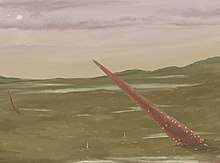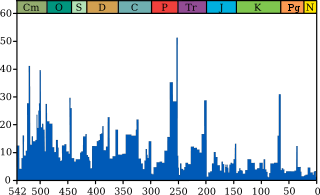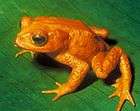Ordovician–Silurian extinction events
The Ordovician–Silurian extinction events, also known as the Late Ordovician mass extinction (LOME), are collectively the second-largest of the five major extinction events in Earth's history in terms of percentage of genera that became extinct. Extinction was global during this period, eliminating 49–60% of marine genera and nearly 85% of marine species.[1] Only the Permian-Triassic mass extinction exceeds the LOME in total biodiversity loss. The extinction event abruptly affected all major taxonomic groups and caused the disappearance of one third of all brachiopod and bryozoan families, as well as numerous groups of conodonts, trilobites, echinoderms, corals, bivalves, and graptolites.[2][3] This extinction was the first of the "big five" Phanerozoic mass extinction events and was the first to significantly affect animal-based communities.[4] However, the LOME did not produce major changes to ecosystem structures compared to other mass extinctions, nor did it lead to any particular morphological innovations. Diversity gradually recovered to pre-extinction levels over the first 5 million years of the Silurian period.[5][6][7][8]
The Late Ordovician mass extinction is generally considered to occur in two distinct pulses.[8] The first pulse began at the boundary between the Katian and Hirnantian stages of the Late Ordovician Period. This extinction pulse is typically attributed to the Late Ordovician glaciation, which abruptly expanded over Gondwana at the beginning of the Hirnantian and shifted the earth from a greenhouse to icehouse climate.[3][9] Cooling and a falling sea level brought on by the glaciation led to habitat loss for many organisms along the continental shelves, especially endemic taxa with restricted temperature tolerance.[9] During this extinction pulse there were also several marked changes in biologically responsive carbon and oxygen isotopes.[8] Marine life partially rediversified during the cold period and a new cold-water ecosystem, the "Hirnantia biota", was established.[8]
The second pulse of extinction occurred in the later half of the Hirnantian as the glaciation abruptly recedes and warm conditions return. The second pulse is associated with intense worldwide anoxia (oxygen depletion) and euxinia (toxic sulfide production), which persist into the subsequent Rhuddanian stage of the Silurian Period.[10][8][11]
Impact on life
The extinction followed the Great Ordovician Biodiversification Event, one of the largest evolutionary surges in the geological and biological history of the Earth.[12]
At the time of the extinction, most complex multicellular organisms lived in the sea, and around 100 marine families became extinct, covering about 49%[13] of faunal genera (a more reliable estimate than species). The brachiopods and bryozoans were decimated, along with many of the trilobite, conodont and graptolite families.[8] Each extinction pulse affected different groups of animals and was followed by a rediversification event. Statistical analysis of marine losses at this time suggests that the decrease in diversity was mainly caused by a sharp increase in extinctions, rather than a decrease in speciation.[14]
Following such a major loss of diversity, Silurian communities were initially less complex and broader niched. Highly endemic faunas, which characterized the Late Ordovician, were replaced by faunas that were amongst the most cosmopolitan in the Phanerozoic, biogeographic patterns that persisted throughout most of the Silurian.[4] The Late Ordovician mass extinction had few of the long-term ecological impacts associated with the Permian–Triassic and Cretaceous–Paleogene extinction events.[5][7] Nevertheless, a large number of taxa disappeared from the Earth over a short time interval,[4] eliminating and altering the relative diversity and abundance of certain groups. Cambrian-type fauna such as trilobites and inarticulate brachiopods never recovered their pre-extinction diversity.[8]
Trilobites were hit hard by both phases of the extinction, with about 70% of genera going extinct between the Katian and Silurian. The extinction disproportionately affected deep water species and groups with fully planktonic larvae or adults. The order Agnostida was completely wiped out, and the formerly diverse Asaphida survived with only a single genus, Raphiophorus.[15][16][8]
Glaciation
The first pulse of the Late Ordovician Extinction has been attributed to the Late Ordovician Glaciation. Although there was a longer cooling trend in Middle and Lower Ordovician, the most severe and abrupt period of glaciation occurred in the Hirnantian stage, which was bracketed by both pulses of the extinction. The rapid continental glaciation was centered on Gondwana, which was located at the South Pole in the Late Ordovician. The Hirnantian glaciation is considered one of the most severe ice age of the Paleozoic, which previously maintained the relatively warm climate conditions of a greenhouse earth.[12]
The cause of the glaciation is uncertain and controversial. The appearance and development of terrestrial plants and microphytoplankton, which consumed atmospheric carbon dioxide, may have diminished the greenhouse effect and promoting the transition of the climatic system to the glacial mode.[10] Though more commonly associated with greenhouse gasses and warming, volcanism may have induced cooling. Volcanoes can supply cooling sulfur aerosols to the atmosphere or deposit basalt flows which accelerate carbon sequestration in a tropical environment.[17] Increased burial of organic carbon is another method of drawing down carbon dioxide from the air.[18]

Two environmental changes associated with the glaciation were responsible for much of the Late Ordovician extinction. First, the cooling global climate was probably especially detrimental because the biota were adapted to an intense greenhouse. Second, sea level decline, caused by sequestering of water in the ice cap, drained the vast epicontinental seaways and eliminated the habitat of many endemic communities.
As the southern supercontinent Gondwana drifted over the South Pole, ice caps formed on it. Correlating rock strata have been detected in Late Ordovician rock strata of North Africa and then-adjacent northeastern South America, which were south-polar locations at the time. Glaciation locks up water from the world-ocean, and the interglacials free it, causing sea levels repeatedly to drop and rise; the vast shallow mediterranean Ordovician seas withdrew, which eliminated many ecological niches, then returned, carrying diminished founder populations lacking many whole families of organisms. Then they withdrew again with the next pulse of glaciation, eliminating biological diversity at each change (Emiliani 1992 p. 491). In the North African strata, five pulses of glaciation from seismic sections are recorded.[19]
This incurred a shift in the location of bottom-water formation, shifting from low latitudes, characteristic of greenhouse conditions, to high latitudes, characteristic of icehouse conditions, which was accompanied by increased deep-ocean currents and oxygenation of the bottom-water. An opportunistic fauna briefly thrived there, before anoxic conditions returned. The breakdown in the oceanic circulation patterns brought up nutrients from the abyssal waters. Surviving species were those that coped with the changed conditions and filled the ecological niches left by the extinctions.
Other possible causes
Metal poisoning
Toxic metals on the ocean floor may have dissolved into the water when the oceans' oxygen was depleted. An increase in available nutrients in the oceans may have been a factor, and decreased ocean circulation caused by global cooling may also have been a factor.[20]
The toxic metals may have killed life forms in lower trophic levels of the food chain, causing a decline in population, and subsequently resulting in starvation for the dependent higher feeding life forms in the chain.[21][22]
Gamma-ray burst
Some scientists have suggested that the initial extinctions could have been caused by a gamma-ray burst originating from a hypernova in a nearby arm of the Milky Way galaxy, within 6,000 light-years of Earth. A ten-second burst would have stripped the Earth's atmosphere of half of its ozone almost immediately, exposing surface-dwelling organisms, including those responsible for planetary photosynthesis, to high levels of extreme ultraviolet radiation.[23][24][25][26] Under this hypothesis, several groups of marine organisms with a planktonic lifestyle were more exposed to UV radiation than groups that lived on the seabed. This is consistent with observations that planktonic organisms suffered severely during the first extinction pulse. In addition, species dwelling in shallow water were more likely to become extinct than species dwelling in deep water. A gamma-ray burst could also explain the rapid onset of glaciation, since ozone and nitrogen would react to form nitrogen dioxide, a darkly-colored aerosol which cools the earth.[23] Although the gamma-ray burst hypothesis is consistent with some patterns at the onset of extinction, there is no unambiguous evidence that such a nearby gamma-ray burst ever happened.[10]
Volcanism and weathering
The late Ordovician glaciation was preceded by a fall in atmospheric carbon dioxide (from 7,000 ppm to 4,400 ppm).[27][28] The dip is correlated with a burst of volcanic activity that deposited new silicate rocks, which draw CO2 out of the air as they erode. A major role of CO2 is implied by a 2009 paper.[29] Atmospheric and oceanic CO2 levels may have fluctuated with the growth and decay of Gondwanan glaciation.[30] Through the Late Ordovician, outgassing from major volcanism was balanced by heavy weathering of the uplifting Appalachian Mountains, which sequestered CO2. In the Hirnantian Stage the volcanism ceased, and the continued weathering caused a significant and rapid draw down of CO2.[28] This coincides with the rapid and short ice age.
The appearance and development of terrestrial plants and microphytoplankton, which consumed atmospheric carbon dioxide, thus, diminishing the greenhouse effect and promoting the transition of the climatic system to the glacial mode, played a unique role in that period.[10] During this extinction event there were also several marked changes in biologically responsive carbon and oxygen isotopes.[8]
More recently, in May 2020, a study suggested the first pulse of mass extinction was caused by volcanism which induced global warming and anoxia, rather than cooling and glaciation.[31][32]
See also
Sources
- Christie, M.; Holland, S. M.; Bush, A. M. (2013). "Contrasting the ecological and taxonomic consequences of extinction". Paleobiology. 39 (4): 538–559. doi:10.1666/12033. ProQuest 1440071324.
- Elewa, Ashraf (2008). Late Ordovician Mass Extinction. p. 252. ISBN 978-3-540-75915-7.
- Sole, R. V.; Newman, M. (2002). "The earth system: biological and ecological dimensions of global environment change". Encyclopedia of Global Environmental Change, Volume Two: Extinctions and Biodiversity in the Fossil Record. John Wiley & Sons. pp. 297–391.
- Harper, D. A. T.; Hammarlund, E. U.; Rasmussen, C. M. Ø. (May 2014). "End Ordovician extinctions: A coincidence of causes". Gondwana Research. 25 (4): 1294–1307. Bibcode:2014GondR..25.1294H. doi:10.1016/j.gr.2012.12.021.
- Droser, Mary L.; Bottjer, David J.; Sheehan, Peter M. (1997-02-01). "Evaluating the ecological architecture of major events in the Phanerozoic history of marine invertebrate life". Geology. 25 (2): 167–170. doi:10.1130/0091-7613(1997)0252.3.CO;2. ISSN 0091-7613.
- Droser, Mary L.; Bottjer, David J.; Sheehan, Peter M.; McGhee, George R. (2000-08-01). "Decoupling of taxonomic and ecologic severity of Phanerozoic marine mass extinctions". Geology. 28 (8): 675–678. doi:10.1130/0091-7613(2000)282.0.CO;2. ISSN 0091-7613.
- Brenchley, P. J.; Marshall, J. D.; Underwood, C. J. (2001). "Do all mass extinctions represent an ecological crisis? Evidence from the Late Ordovician". Geological Journal. 36 (3–4): 329–340. doi:10.1002/gj.880. ISSN 1099-1034.
- Sheehan, Peter M (May 2001). "The Late Ordovician Mass Extinction". Annual Review of Earth and Planetary Sciences. 29 (1): 331–364. doi:10.1146/annurev.earth.29.1.331. ISSN 0084-6597.
- "Causes of the Ordovician Extinction". Archived from the original on 2008-05-09.
- Barash, M. (November 2014). "Mass Extinction of the Marine Biota at the Ordovician–Silurian Transition Due to Environmental Changes". Oceanology. 54 (6): 780–787. Bibcode:2014Ocgy...54..780B. doi:10.1134/S0001437014050014.
- Stockey, Richard G.; Cole, Devon B.; Planavsky, Noah J.; Loydell, David K.; Frýda, Jiří; Sperling, Erik A. (14 April 2020). "Persistent global marine euxinia in the early Silurian". Nature Communications. 11 (1): 1–10. doi:10.1038/s41467-020-15400-y. ISSN 2041-1723. PMID 32286253. Retrieved 16 May 2020.
- Munnecke, A.; Calner, M.; Harper, D. A. T.; Servais, T. (2010). "Ordovician and Silurian sea-water chemistry, sea level, and climate: A synopsis". Palaeogeography, Palaeoclimatology, Palaeoecology. 296 (3–4): 389–413. Bibcode:2010PPP...296..389M. doi:10.1016/j.palaeo.2010.08.001.
- Rohde & Muller; Muller, RA (2005). "Cycles in Fossil Diversity". Nature. 434 (7030): 208–210. Bibcode:2005Natur.434..208R. doi:10.1038/nature03339. PMID 15758998.
- Bambach, R.K.; Knoll, A.H.; Wang, S.C. (December 2004). "Origination, extinction, and mass depletions of marine diversity". Paleobiology. 30 (4): 522–542. doi:10.1666/0094-8373(2004)030<0522:OEAMDO>2.0.CO;2.
- Chatterton, Brian D. E.; Speyer, Stephen E. (1989). "Larval ecology, life history strategies, and patterns of extinction and survivorship among Ordovician trilobites". Paleobiology. 15 (2): 118–132. doi:10.1017/S0094837300009313. ISSN 0094-8373. JSTOR 2400847.
- Owen, Alan W.; Harper, David A.T.; Rong, Jia-Yu (1991). "Hirnantian trilobites and brachiopods in space and time" (PDF). In C.R. Barnes, S.H. Williams (ed.). Advances in Ordovician Geology. Geological Survey of Canada. pp. 179–190. doi:10.4095/132187.
- Jones, David S.; Martini, Anna M.; Fike, David A.; Kaiho, Kunio (2017-07-01). "A volcanic trigger for the Late Ordovician mass extinction? Mercury data from south China and Laurentia". Geology. 45 (7): 631–634. doi:10.1130/G38940.1. ISSN 0091-7613.
- Saltzman, Matthew R.; Young, Seth A. (2005-02-01). "Long-lived glaciation in the Late Ordovician? Isotopic and sequence-stratigraphic evidence from western Laurentia". Geology. 33 (2): 109–112. doi:10.1130/G21219.1. ISSN 0091-7613.
- "Archived copy" (PDF). Archived from the original (PDF) on 2011-07-27. Retrieved 2009-07-22.CS1 maint: archived copy as title (link) IGCP meeting September 2004 reports pp 26f
- Bartlett, Rick; Elrick, Maya; Wheeley, James R.; Polyak, Victor; Desrochers, André; Asmerom, Yemane (2018). "Abrupt global-ocean anoxia during the Late Ordovician–early Silurian detected using uranium isotopes of marine carbonates". Proceedings of the National Academy of Sciences. 115 (23): 5896–5901. Bibcode:2018PNAS..115.5896B. doi:10.1073/pnas.1802438115. PMC 6003337. PMID 29784792.
- Katz, Cheryl (2015-09-11). "New Theory for What Caused Earth's Second-Largest Mass Extinction". National Geographic News. Retrieved 2015-09-12.
- Vandenbroucke, Thijs R. A.; Emsbo, Poul; Munnecke, Axel; Nuns, Nicolas; Duponchel, Ludovic; Lepot, Kevin; Quijada, Melesio; Paris, Florentin; Servais, Thomas (2015-08-25). "Metal-induced malformations in early Palaeozoic plankton are harbingers of mass extinction". Nature Communications. 6. Article 7966. Bibcode:2015NatCo...6.7966V. doi:10.1038/ncomms8966. PMC 4560756. PMID 26305681.
- Melott, A.L.; et al. (2004). "Did a gamma-ray burst initiate the late Ordovician mass extinction?". International Journal of Astrobiology. 3 (2): 55–61. arXiv:astro-ph/0309415. Bibcode:2004IJAsB...3...55M. doi:10.1017/S1473550404001910.
- Wanjek, Christopher (April 6, 2005). "Explosions in Space May Have Initiated Ancient Extinction on Earth". NASA. Retrieved 2008-04-30.
- "Ray burst is extinction suspect". BBC. April 6, 2005. Retrieved 2008-04-30.
- Melott, A.L. & Thomas, B.C. (2009). "Late Ordovician geographic patterns of extinction compared with simulations of astrophysical ionizing radiation damage". Paleobiology. 35 (3): 311–320. arXiv:0809.0899. doi:10.1666/0094-8373-35.3.311.
- Seth A. Young, Matthew R. Saltzman, William I. Ausich, André Desrochers, and Dimitri Kaljo, "Did changes in atmospheric CO2 coincide with latest Ordovician glacial–interglacial cycles?", Palaeogeography, Palaeoclimatology, Palaeoecology, Vol. 296, No. 3–4, 15 October 2010, Pages 376–388.
- Jeff Hecht, High-carbon ice age mystery solved, New Scientist, 8 March 2010 (retrieved 30 June 2014)
- Young. S.A.; et al. (2009). "A major drop in seawater 87Sr/86Sr during the Middle Ordovician (Darriwilian): Links to volcanism and climate?" (PDF). Geology. 37 (10): 951–954. Bibcode:2009Geo....37..951Y. doi:10.1130/G30152A.1. Retrieved 2017-10-23.
- "Get it! Helper Window | University of Toronto Libraries". simplelink.library.utoronto.ca. Retrieved 2016-04-08.
- Hall, Shannon (10 June 2020). "Familiar Culprit May Have Caused Mysterious Mass Extinction - A planet heated by giant volcanic eruptions drove the earliest known wipeout of life on Earth". The New York Times. Retrieved 15 June 2020.
- Bond, David P.G.; Grasby, Stephen E. (18 May 2020). "Late Ordovician mass extinction caused by volcanism, warming, and anoxia, not cooling and glaciation". Geology (journal). doi:10.1130/G47377.1. Retrieved 15 June 2020.
- "The history of ice on Earth". newscientist.com. Retrieved 12 April 2018.
Further reading
- Gradstein, Felix M.; Ogg, James G.; Smith, Alan G. (2004). A Geological Time Scale 2004 (3rd ed.). Cambridge University Press: Cambridge University Press. ISBN 9780521786737.
- Hallam, Anthony; Paul B., Wignall (1997). Mass Extinctions and Their Aftermath. Oxford University Press. ISBN 9780191588396.
- Webby, Barry D.; Paris, Florentin; Droser, Mary L.; Percival, Ian G, eds. (2004). The great Ordovician biodiversification event. New York: Columbia University Press. ISBN 9780231501637.
External links
- Jacques Veniers, "The end-Ordovician extinction event": abstract of Hallam and Wignall, 1997.

